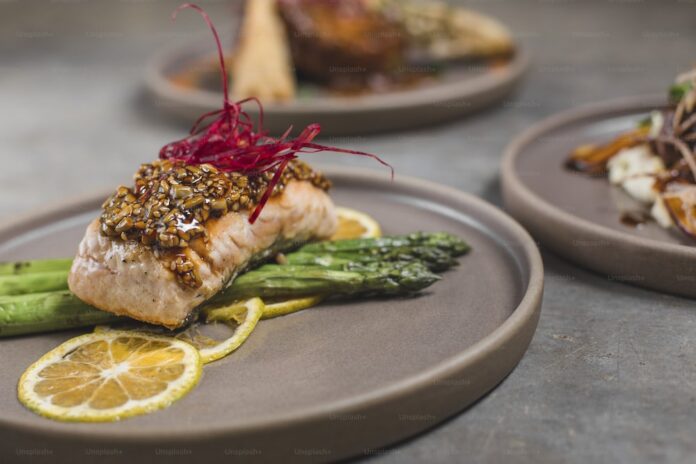As someone who has been following the keto diet for a while, I can tell you that it’s not easy to come up with meal ideas that are both delicious and within the guidelines of the diet. That’s why I’m excited to share with you my guide to crafting delicious keto recipes for beginners. In this article, I’ll cover everything from the basics of keto cooking to tips for meal planning and prepping, as well as some of my favorite keto recipe resources. Let’s get started!
In This Article
Introduction to the Keto Diet and Its Benefits
Before we dive into the cooking aspect of the keto diet, let’s first discuss what it is and why people choose to follow it. The ketogenic diet is a low-carb, high-fat diet that has been shown to help with weight loss, improve blood sugar control, and reduce the risk of certain diseases such as heart disease and diabetes.
The reason the keto diet is so effective for weight loss is that it puts your body into a state of ketosis, where it burns fat instead of carbohydrates for energy. This is achieved by limiting your daily carb intake to 20-50 grams, or about 5-10% of your daily calories, and increasing your fat intake to 70-80% of your daily calories.
The Basics of Keto Cooking
Now that you understand the basics of the keto diet, it’s time to talk about cooking. The key to successful keto cooking is to focus on whole, unprocessed foods that are high in healthy fats and low in carbs. This means that you should avoid things like bread, pasta, and sugar, and instead focus on foods like meat, fish, eggs, vegetables, and nuts.
When it comes to cooking methods, keto-friendly options include grilling, roasting, sautéing, and baking. You’ll also want to make sure you have plenty of healthy fats on hand, such as olive oil, coconut oil, and butter, as these will be the main source of calories in your meals.
Essential Ingredients for Keto Recipes
To make delicious keto recipes, you’ll need to have a few essential ingredients on hand. These include:
- Healthy fats: as mentioned before, you’ll want to have a variety of healthy fats on hand to use in your recipes. These can include olive oil, coconut oil, avocado oil, and butter.
- Low-carb vegetables: vegetables are an important part of any healthy diet, and on the keto diet, you’ll want to focus on low-carb options like leafy greens, broccoli, cauliflower, and zucchini.
- High-quality protein: meat, fish, and eggs are all great sources of protein on the keto diet. Look for grass-fed and organic options when possible.
- Nuts and seeds: these can be a great source of healthy fats and protein, but be careful not to overdo it as they can also be high in carbs.
Quick and Easy Keto Meals for Beginners
One common misconception about the keto diet is that it’s difficult and time-consuming to prepare meals. However, that’s not necessarily the case. Here are a few quick and easy keto meals that are perfect for beginners:
- Grilled chicken with roasted broccoli and cauliflower
- Sautéed shrimp with zucchini noodles and pesto
- Baked salmon with roasted Brussels sprouts and bacon
- Steak fajitas with bell peppers and onions (just skip the tortillas!)
Delicious Keto Breakfast Ideas
Breakfast can be a tricky meal on the keto diet, as many traditional breakfast foods are high in carbs. However, with a little creativity, you can still enjoy a delicious and satisfying breakfast. Here are a few keto breakfast ideas to get you started:
- Egg muffins with spinach and feta
- Avocado toast with a low-carb bread alternative
- Greek yogurt with berries and nuts
- Bacon and eggs with sautéed mushrooms
Tips for Meal Planning and Prepping on a Keto Diet
One of the keys to success on the keto diet is to plan ahead. Here are a few tips for meal planning and prepping on a keto diet:
- Plan your meals for the week ahead of time, and make a grocery list to ensure you have all the necessary ingredients.
- Batch cook meals on the weekend, so you have healthy options ready to go throughout the week.
- Keep healthy snacks on hand, such as nuts, seeds, or jerky, to avoid reaching for carb-heavy options when hunger strikes.
Creative Ways to Add Flavor to Your Keto Recipes
One of the biggest challenges of the keto diet can be finding ways to add flavor to your meals without relying on carbs. Here are a few creative ways to add flavor to your keto recipes:
- Use herbs and spices liberally in your cooking. Cumin, paprika, and garlic are all great options.
- Experiment with different types of vinegar, such as balsamic or apple cider vinegar, to add tanginess to your meals.
- Use high-quality sea salt to bring out the flavors in your food.
Common Mistakes to Avoid When Cooking Keto
Finally, let’s talk about some common mistakes to avoid when cooking keto. These include:
- Not getting enough healthy fats: remember, healthy fats are a crucial part of the keto diet, so make sure you’re incorporating them into your meals.
- Eating too much protein: while protein is important, eating too much can actually kick you out of ketosis. Stick to moderate amounts of protein.
- Not tracking your carb intake: it’s important to keep track of your daily carb intake to ensure you stay within the guidelines of the diet.
Keto Recipe Resources and Cookbooks
If you’re looking for more keto recipe ideas, there are plenty of resources available. Here are a few of my favorites:
- 21-day keto meal plan
- 500 Easy and Delicious Keto Recipes E-book
- Custom Keto Diet – Updated For 2023
Conclusion and Final Thoughts
In conclusion, the keto diet can be a delicious and satisfying way to improve your health and lose weight. By focusing on whole, unprocessed foods that are high in healthy fats and low in carbs, you can create meals that are both nutritious and flavorful. With these tips and resources, you’ll be well on your way to crafting delicious keto recipes for beginners. Good luck, and happy cooking!
Looking for more keto recipe ideas? Check out our recipe section for inspiration!









